Choosing between a suit and a tuxedo can be confusing. Many invitations don’t explain the difference. You risk feeling out of place if you choose the wrong one. Knowing when to wear each is important for looking sharp and feeling confident at any event.
If you show up in a suit when a tuxedo is expected, you might look underdressed. Wearing a tuxedo to a casual gathering can make you stand out for the wrong reasons. The details matter more than you think, from fabric choices to accessories.
Here’s the simple answer: A suit is versatile for most occasions, while a tuxedo is for strictly formal events. Learn the key differences so you never guess again. This blog will make it easy to choose the right look and help you feel comfortable at your next event.
Key Takeaways
- Tuxedos feature satin or grosgrain details on lapels and pants, while suits use the same fabric throughout for a more understated look.
- Tuxedos are reserved for formal evening or black-tie events, while suits are versatile for business, social, and semi-formal occasions.
- Tuxedos are worn with a white dress shirt, bow tie, formal accessories, and patent shoes; suits allow varied shirt, tie, and shoe options.
- Suit colors and fabrics are diverse and include patterns, while tuxedos are usually solid black, midnight blue, or white with minimal patterning.
- Tuxedo pants have a satin stripe and no belt loops, while suit pants lack satin accents and typically include belt loops.
Historical Origins of Suits and Tuxedos
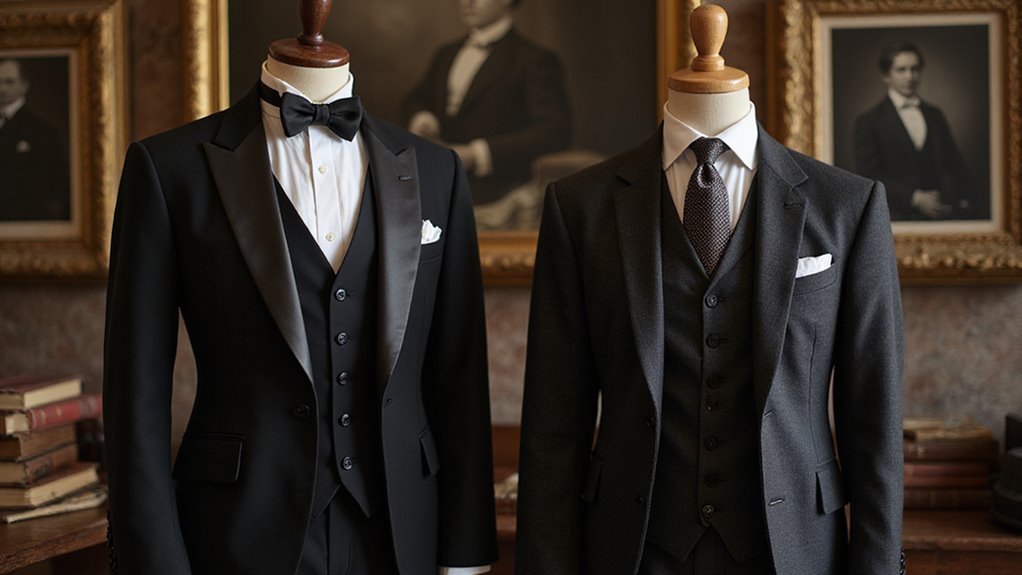
Suits and tuxedos have different historical origins. The modern suit comes from early 19th-century British tailoring. Tailors changed the frock coat into a lounge suit for more comfort and practicality. Suits became popular for daily use in cities. If you look at tuxedos, they started in the late 1800s. The tuxedo got its name from Tuxedo Park, New York. It appeared as a less formal option than the tailcoat.
Satin lapels and silk details set tuxedos apart for evening events. Knowing these histories shows how social changes shaped formal dress codes. Many modern brands now use digital mockups to preview and refine formalwear designs before creating physical samples. Designers today often use realistic previews to visualize how suits and tuxedos will look in different settings before final production.
Key Features of a Classic Suit
When you choose a classic suit, you’re prioritizing versatile styling options that adapt to business, social, and semi-formal settings. You’ll notice a wide spectrum of fabrics—like worsted wool, linen, or cotton—and an array of colors from navy to charcoal, supporting year-round wear. This makes the suit an essential foundation for everyday formal attire, balancing comfort, function, and timeless aesthetics.
Classic suits are distinguished by their timeless structure and clean lines, which offer a sharp yet adaptable look for a wide variety of occasions. Additionally, modern suit designs often benefit from high customization options that allow for tailored fits, adjustable backgrounds, and detail enhancements, making them especially valuable for both personal style and professional presentations.
Versatile Styling Options
Classic suits give you many ways to style your look. You can wear the jacket with matching or different trousers. If you choose a double-breasted jacket, you get a more formal look. Lapel choices like notch, peak, or shawl fit different events. You may pick a shirt and tie that suits the occasion. If you add a vest, your outfit becomes more formal. Wearing only the jacket and trousers makes the outfit less formal. These options help you dress well for both day and night.
Fabric and Color Choices
Fabric and color are important when choosing a suit. The fabric affects durability and comfort. Wool is strong and allows airflow. Cotton offers softness but holds its shape well.
Synthetic blends last longer but lack a natural feel. If you want a certain look, pick your color carefully. Navy looks professional, charcoal shows power, and lighter colors seem friendly.
Here’s a quick reference:
| Fabric Type | Durability Level | Common Color Symbolism |
|---|---|---|
| Wool | High | Authority, Sophistication |
| Cotton | Medium | Relaxed, Modern |
| Synthetic | Variable | Versatile, Functional |
Everyday Formal Wear
Everyday formal wear often means wearing a classic suit. A classic suit has clean lines and a structured fit. It usually features single- or double-breasted closures and shaped shoulders. Trousers have a tailored cut and little or no break. Most suits use durable fabrics like worsted wool or light blends. Common colors are navy, grey, and charcoal because they match with many items.
Classic suits do not have shiny satin details like tuxedos. They often include flap pockets and notch lapels for practicality. You can wear a suit with an open-collar shirt if you want a relaxed look. If it is cold, layer your suit over knitwear. This makes the suit useful for many situations.
Defining Characteristics of a Tuxedo
A tuxedo has specific features that make it different from other formalwear. Satin is used on the lapels, buttons, and pocket trims. This gives the tuxedo a smooth and shiny look. If you see bow ties, cummerbunds, or formal studs, you are likely looking at a tuxedo. Most tuxedos use dark, solid fabrics instead of patterns. The shirt has a pleated or pique front, which adds to the formal look. If you need to identify a tuxedo, check for the following:
| Feature | Tuxedo Specification |
|---|---|
| Lapel Material | Satin or grosgrain |
| Button Type | Satin-covered or fabric |
| Accessories | Bow tie, cummerbund, studs |
| Shirt Style | Pleated or pique front |
| Fabric Pattern | Solid, usually no patterns |
The use of digital model mockups can help designers and clients preview exactly how these formal elements will appear on a tuxedo before production. The use of realistic representations in digital mockups can help visualize the formal elements of a tuxedo before production.
Differences in Jacket Design
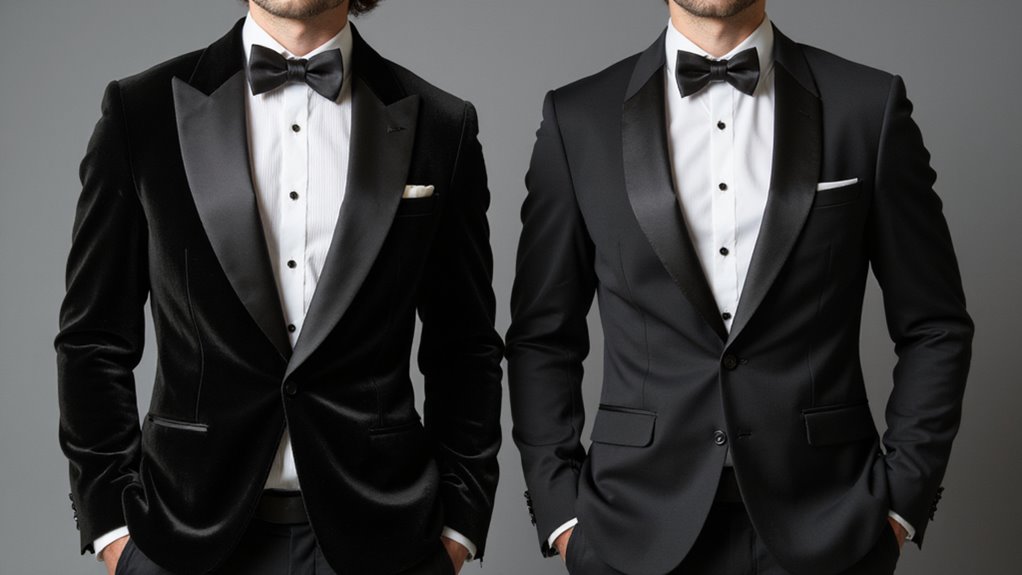
Jacket design sets the level of formality in your outfit. Tuxedo jackets have satin or grosgrain on the lapels, buttons, and pocket edges. These shiny details make tuxedos look very formal. Suit jackets use the same fabric for lapels and buttons, which gives a less shiny and more relaxed look.
If you check the back, tuxedos usually have one vent or none at all. Suit jackets often have two vents for ease of movement. Tuxedos also feature flat besom pockets and structured shoulders for a sharp shape. Suit jackets include flap pockets and softer shoulders, making them fit many occasions. If you want more flexibility, choose a suit jacket. If you need high formality, pick a tuxedo. Designers often use mockup customization to experiment with these jacket details before finalizing a look.
Just as in visual presentation, the details in jacket design—such as lapel material and pocket style—play a key role in conveying the right level of formality for your look.
Variation in Pant Styles
When you compare pant styles, you’ll notice tuxedo trousers feature a distinctive satin stripe along the outer seam, while suit pants don’t. Pay attention to the waistband—tuxedo pants typically use side adjusters or brace buttons, unlike the belt loops found on most suit trousers. Pant leg silhouettes also differ, with tuxedo pants favoring a slim, streamlined fit for formal aesthetics.
Notably, these design distinctions emphasize the formality level of tuxedos compared to suits. Additionally, the level of personalization and fit can vary between tuxedo and suit pants depending on whether they are custom or bespoke, with bespoke options offering the highest degree of tailoring for a truly unique garment.
Satin Stripe Details
Tuxedo pants have a satin stripe on the outer seam. This satin stripe is a mark of formality. Suit pants do not have any satin stripes. They use the same fabric for both jacket and pants. The satin stripe on tuxedos matches the satin lapels. If you want a formal look, choose tuxedo pants with a satin stripe. A suit is better if you want a simple or business look. The satin stripe helps tuxedos stand out at special evening events.
Waistband Design Differences
Suit pants have belt loops and are worn with a belt. This design is common in everyday clothing for comfort and adjustment. Tuxedo pants do not have belt loops. They use side adjusters or inside waist tabs instead. The waistband often has satin to match other tuxedo details. If you want a clean and formal look, choose tuxedo pants. Their design helps keep the outfit smooth and elegant.
Pant Leg Silhouettes
Pant leg silhouettes help distinguish suits from tuxedos. Suit pants come in many shapes, such as slim, classic, or modern fits. These pants often have a lower rise and different pocket styles for comfort and style. Pockets can be slanted or have a welt design, adding practicality.
Tuxedo pants look more formal and simple. They usually have a higher rise and a straight or slightly tapered leg. Pockets are vertical or besom to keep the look smooth. A satin stripe runs along the outseam, making tuxedo pants look longer and more elegant. If you want a formal style, tuxedo pants are the best choice.
Lapels: Notch, Peak, and Shawl
Lapels come in three main styles: notch, peak, and shawl. Each style affects how formal a suit or tuxedo looks. Notch lapels have a V-shaped cut and are common on business suits. Peak lapels have pointed tips and are often seen on formal suits and tuxedos. Shawl lapels are rounded and mostly found on tuxedos, adding a smooth look. Tuxedo lapels often use shiny satin or grosgrain fabric for contrast.
Business suits usually have lapels made from the same fabric as the rest of the jacket. Just like the way PSD mockup templates offer various customization options for shirt designs, lapel styles and fabrics help define the overall look and formality of a suit or tuxedo. Choosing the right lapel can also be essential for visual storytelling in fashion presentations, as it sets the tone for the design’s intended message and audience.
- Notch lapels: best for business suits, less formal.
- Peak lapels: look sharp, good for formal occasions.
- Shawl lapels: rounded, best for tuxedos and black-tie events.
- Lapel fabric: satin or grosgrain adds shine, self-fabric keeps it simple.
Buttons and Closures Compared
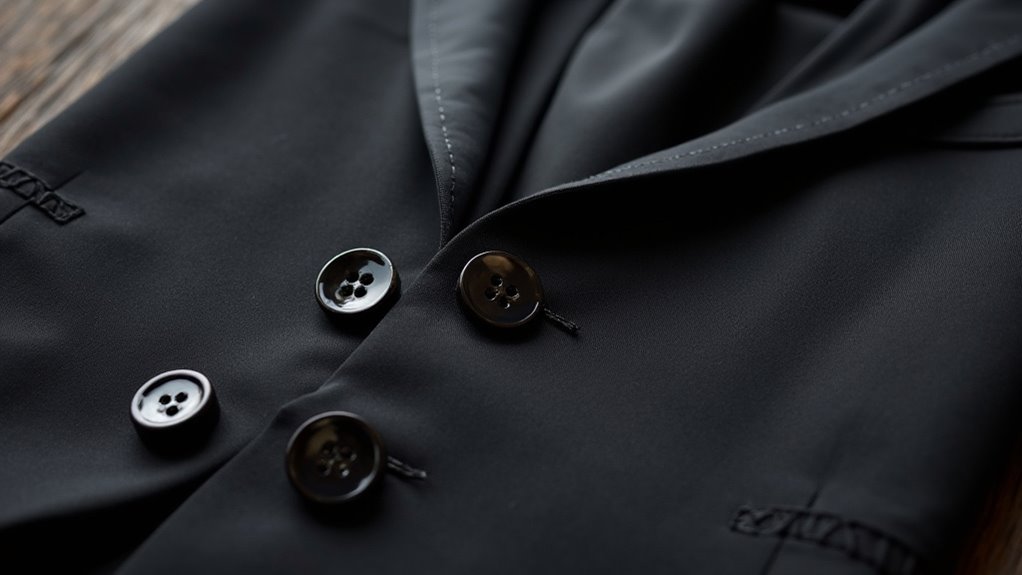
Buttons and closures are important details that set suits and tuxedos apart. Suits usually have plastic, horn, or fabric-covered buttons. These buttons match the suit’s fabric and style. Suits often come in single or double-breasted designs. They usually have two or three buttons on the front. Tuxedos use covered or silk-faced buttons for a more formal look. Most tuxedos have a single-button closure.
If you look at tuxedo shirts, they may use decorative studs instead of regular buttons. These choices make tuxedos appear more elegant and formal. Fashion designers often use realistic previews in professional presentations to help clients visualize subtle differences like button and closure types. Paying attention to the material and design of buttons and closures can also help you recognize the level of formality and the intended occasion for each garment.
Fabric and Material Distinctions
Suits and tuxedos use different fabrics to show their level of formality. Tuxedos use high-quality wool with satin or grosgrain details on lapels, buttons, and side stripes. Suits use more types of fabric, such as linen and cotton blends, allowing for casual or formal looks.
Satin lapels and covered buttons give tuxedos a shiny, formal look. Suits can feature textured weaves like tweed or herringbone for daily use. Tuxedos do not use casual fabrics, keeping them suitable for formal events. Fabric choice helps decide if the outfit fits the event and tradition. Unlike tuxedos, sport coats and blazers are often made from patterned or more durable fabrics, reflecting their typically less formal use.
Shirt Choices for Each Ensemble
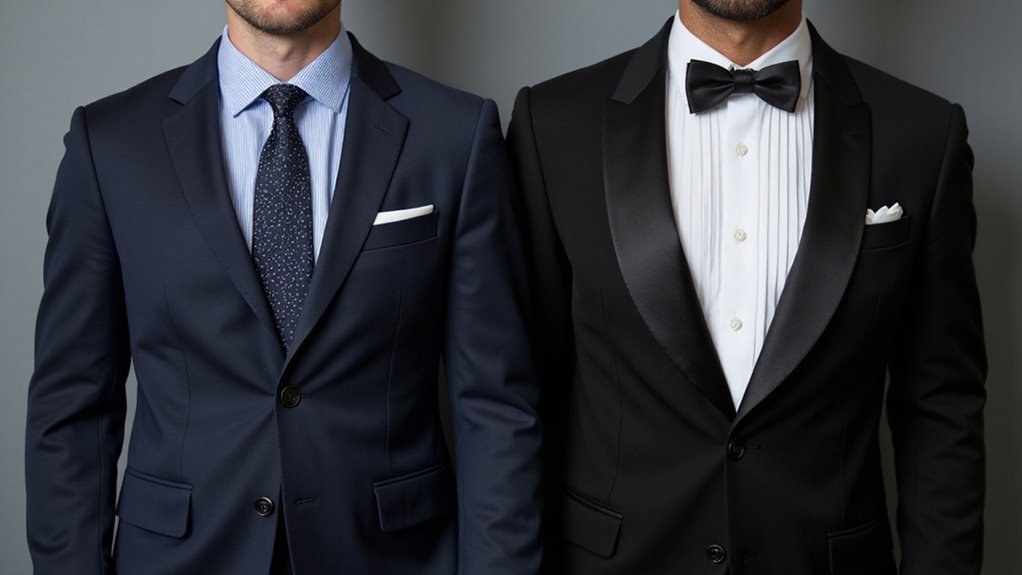
Both tuxedos and suits require dress shirts, but tuxedos need more formal options. Tuxedos always pair with a crisp, white shirt. This shirt often has pleats or a bib front. You should use studs and cufflinks with a tuxedo shirt. Suits give you more flexibility with shirt choices. You can wear solid, patterned, or even casual button-down shirts with a suit. Never wear athletic shirts or sports fabrics with either outfit. Athletic wear ruins the formal look.
| Ensemble | Shirt Type | Features |
|---|---|---|
| Tuxedo | Formal dress shirt | Pleated or bib front, French cuffs |
| Suit | Classic dress shirt | Solid or patterned fabric |
| Suit | Casual shirt | Button-down, relaxed fit |
| Tuxedo | No athletic wear | Only traditional fabrics |
| Suit | No athletic wear | Keep a tailored appearance |
Appropriate Accessories for Suits and Tuxedos
Accessories complete the look of a suit or tuxedo. Tuxedos need formal accessories like a silk bow tie, waist covering, and cufflinks. Suits allow more options, letting you choose between formal and casual pieces. A tie or pocket square can add color or pattern if you want personality. Simple accessories work best for business events. Careful choices will improve your outfit.
- Bow Tie or Long Tie: Tuxedos require a black silk bow tie. Suits allow silk or wool ties in different colors.
- Cufflinks: Tuxedos always need cufflinks. Suits may use them, and metals should match your watch.
- Pocket Square: Tuxedos need a silk pocket square. Suits look good with linen or cotton versions.
- Boutonnière: Weddings often include a boutonnière, but other events do not require one.
Footwear Pairings for Formal Attire
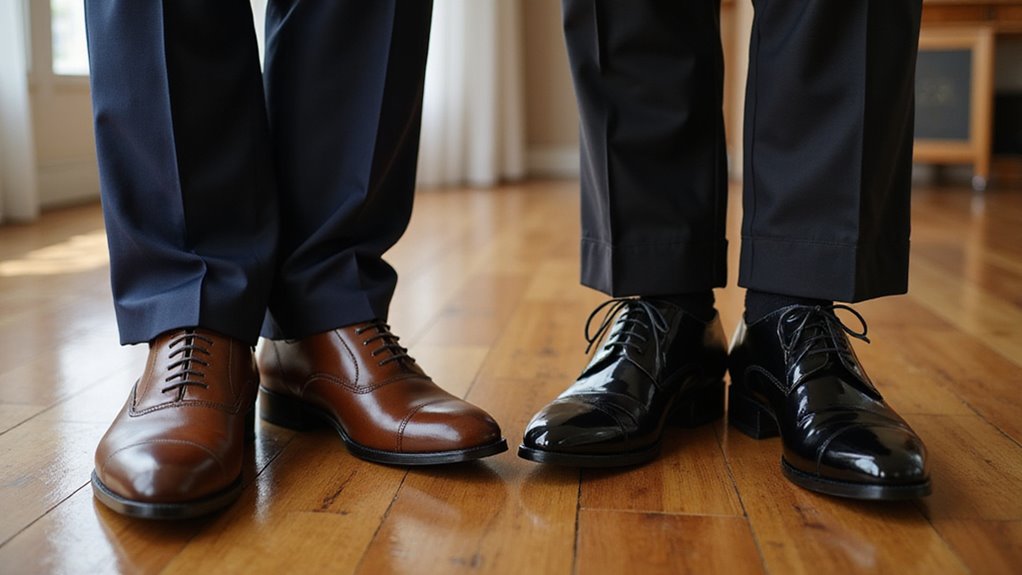
When pairing shoes with formal clothes, always match the shoe style to the outfit. Tuxedos require shiny shoes like patent leather oxfords or opera pumps. These shoes look sharp and match the tuxedo’s formal style. Suits let you choose from leather derbies, monk straps, or brogues. These options give more style choices while staying formal. Never wear casual or outdoor shoes with either outfit. Sneakers and sandals break the formal look and should be avoided.
| Attire | Recommended Shoes | Avoid |
|---|---|---|
| Tuxedo | Patent leather oxfords | Casual footwear |
| Suit | Leather derbies, brogues | Outdoor shoes |
| Both | Black calfskin dress shoes | Sneakers, sandals |
Correct shoe choices keep your outfit neat and sophisticated.
Typical Occasions for Each Outfit
Each outfit fits a specific occasion. Suits and tuxedos are not the same and should be worn for different events. Suits work well for business casual settings, job interviews, or daytime meetings. You can also wear a suit to a casual wedding or a semi-formal event.
Tuxedos are for very formal events, like black-tie galas or evening affairs. If the invitation says “black tie,” you should wear a tuxedo. Choosing the right clothing shows respect for the event and its hosts. Consider the dress code before picking your outfit.
Color Options and Restrictions
Suits come in many colors. Common choices are navy, charcoal, gray, and tan. Some suits have patterns like pinstripes or checks. This variety lets you match shirts, ties, and accessories for different occasions. If you need flexibility, a suit offers more color options.
Tuxedos usually come in black or midnight blue. They have satin lapels and are very formal. White dinner jackets are worn in warm weather or at summer events. Other tuxedo colors are rare in classic formalwear. Tuxedos are paired with a black bow tie and a white shirt. This limited palette keeps the look timeless and formal. If you want a classic style, choose a tuxedo.
Modern Trends and Style Tips
You’ll notice that today’s style landscape favors bold color palettes and unexpected accessory combinations for both suits and tuxedos. Select slim or tailored silhouettes to achieve a streamlined, contemporary fit. Pairing textured fabrics, statement footwear, and unique lapel pins can raise your ensemble with a modern edge.
Current Color Preferences
Color preferences for suits and tuxedos have become more diverse in recent years. Classic black and navy are still popular choices. New trends include deep green, burgundy, and textured charcoal tuxedos. Suits often appear in earth tones and pastels, especially in spring and summer. If you choose a suit, consider your event’s lighting and theme.
Navy and charcoal work well for both business and formal events. Earthy browns, sage, and dusty rose are common in modern collections. Jewel tones like emerald and sapphire add a bold look to evening wear. Subtle plaid or check patterns give suits extra style without being too flashy.
Accessory Pairing Ideas
When choosing accessories for suits and tuxedos, focus on balance and a matching modern look. Suits look good with simple metal or enamel cufflinks. Tuxedos need more formal cufflinks like onyx or mother-of-pearl. If you wear tuxedos, add matching shirt studs for a sharp finish.
Pocket squares with bold patterns suit modern suits. Classic white or simple silk pocket squares work best for tuxedos. Always coordinate, but do not exactly match, your pocket square with your tie or bow tie. Use slim tie bars and lapel pins for a clean look. Make sure all metal accessories match for a unified style.
Fit and Tailoring
Fit and tailoring make a big difference in how a suit or tuxedo looks. Proper tailoring shapes the jacket and pants to your body. Slim-fit styles are popular and make the shoulders and waist look sharp. Tuxedos usually have a close fit and short pant length. Suits can be either fitted or relaxed, depending on the style and season. Lightweight fabric is best for warm weather, while heavier fabric works well in winter.
- Slim-fit jackets follow your body shape and use less fabric.
- Tuxedo pants have a crisp hem, while suit pants can be more relaxed.
- Double vents on the back help with movement and cooling.
- Unstructured suits feel comfortable and work for casual events.
Conclusion
If you want to dress for a formal event, you should consider a tuxedo. Tuxedos have satin details and are worn with special accessories. If you prefer something versatile, you should choose a suit for business or less formal occasions.
If you pay attention to details, you will notice that tuxedos and suits send different messages. Satin lapels and shiny shoes show more formality. Wool suits and leather Oxfords are classic and suitable for daily use.
If you want your outfit to match any event, you should choose carefully. Consider the formality and tradition of each option. For a polished look, use Custom Mockup to visualize your perfect attire before your next big occasion.



No Comment! Be the first one.